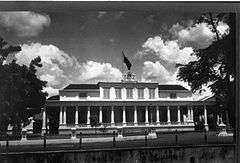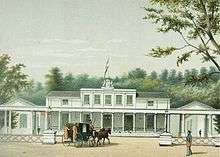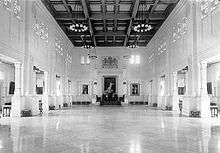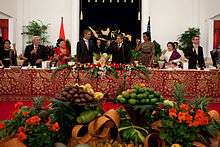Istana Negara (Jakarta)
| Istana Negara (State Palace) | |
|---|---|
 State Palace in 1925 | |
| General information | |
| Architectural style | Indische Empire style |
| Location | Jalan Veteran, no. 17, Jakarta Pusat, Indonesia |
| Construction started | 1796 |
| Client | Governor-General of The Dutch East Indies |
Istana Negara (English: or State Palace, Indonesian: Istana Negara, Dutch: Paleis te Rijswijk) is one of the 6 presidential palaces of Indonesia. It is located Veteran street Central Jakarta, with Merdeka Palace located south of the building. It is part of the presidential palace compound which have a total area of 68,000 m², along with 3 other building: Bina Graha building that was formerly used as the President's Office, Wisma Negara in the western side which is used as state guesthouse and the Sekretariat Negara (State Secretariat). Istana Negara face north towards Jalan Veteran (Veteran Road), while Merdeka Palace that was built in the south are facing Merdeka Square.[1]
History


The building today known as Istana Negara (State Palace) was originally built as the residence for a Dutch businessman, J. A. van Braam in Rijswijk-Molenvliet (presently known as Harmoni). The location chosen as at the time it was the most exclusive neighborhood in Weltevreden area, a new town center south of Old Batavia. The State Palace was built in 1796 facing north toward Molenvliet Canal in Noordwijk (today: Jalan Veteran), during the era of Pieter Gerardus van Overstraten as Governor General, and was completed in 1804.[2][3]
In 1820, the mansion was rented and then sold to the Dutch Colonial Government in 1821. The government used this building as the center of all administration and as the official residence of the Governor-General during a stay in Batavia. Important occasions such as formal ceremonies or the Indies Council Meeting on every Wednesday are held in the palace. Godert van der Capellen became the first governor-general to officially reside in the palace. However Bogor Palace (Paleis te Buitenzorg) in Bogor (Buitenzorg) became the main residence, as most of the governor generals preferred the temperate climate in the hillsides of Bogor.[3]
Governor General Daendels originally intended to have the government centralized in Lapangan Banteng (formerly known as Waterloo Square) and had a palace built there. However the plan wasn't carried out by his preceder and the construction was delayed. Instead the mansion of van Braam in Rijswijk became the residence of the governor-general, while Daendels Palace was later completed in 1828 to become the department of finance building.[4] Hotel van den Gouverneur-Generaal (Hotel of the Governor-General) became the official name of the van Braam mansion.[3] Later the palace becomes too cramped with increasing administrative need, and thus a new palace was planned in 1869. The new palace was completed in 1873 facing Koningsplein (King's Square) and it would be known as Koningsplein Palace. Together the palace would form the Governor-General's palace compound in Rijswijk.
In 1942 the Japanese successfully invaded the Dutch East Indies. Governor-General Tjarda Van Starkenborch signed a capitulation to the Japanese army in the palace on 8 March 1942. Under the Japanese the palace became the residence of the Saiko Shikikan (army commander) until the Japanese surrender in 1945.[3] After the independence, the lion emblem of the Netherlands on the front facade of the building was removed.
Since its existence, many important events took place in this building. Some of which include the declaration of the cultuur stelsel system by the Governor-General Graaf van den Bosch, the ratification ceremony of the Linggadjati Agreement on March 25, 1947 and the recognition of Indonesia's independence on 27 December 1949.[2][3]
Role of the Palace and Feature

The architecture of the Merdeka Palace was done in a neo-classical style with doric column, popular amongst Europeans at the time of construction. During the early days, the 3.375 m² building had two stories. In 1848, the upper floor was partly demolished, and the lower expanded to accommodate more individuals, and thus present a more formal portrayal. The palace mainly functions as the main venue for stately ceremonial activities such as appointments of ministers, conference and national meeting opening ceremonies, the opening of international and national congresses, national banquets and cultural performances. It also serves as an administrative office for the Head of state.[2]
The front part of the palace contains the main reception hall, which is used mainly for Gifts of State exchanges and is located next to the banquet hall. Other chambers in the palace consist of a front room, a living room, a suite for the vice-president, a guest waiting room and the president's office. The palace consists of 2 main audience halls named Ruang Upacara and Ruang Jamuan, each connected with a corridor decorated with various paintings. During the colonial era, Ruang Upacara (Ceremonial Hall) was formerly a ballroom. As its name states, the room is used for formal ceremonial events in the palace. In the room there are Javanese and Balinese Gamelan sets used for cultural performance purposes and a podium. The Ruang Jamuan (Banquet Hall) is used to provide hospitality and repasts to state guests within the palace. It has a capacity of 150 people and is decorated with a painting of Ratu Kidul by Basoeki Abdullah.[2]
See also
- List of colonial buildings and structures in Jakarta
- Cipanas Palace
- Vice Presidential Palace (Indonesia)
Coordinates: 6°10′4.73″S 106°49′26.04″E / 6.1679806°S 106.8239000°E
References
- ↑ Istana Republik Indonesia. Accessed June 20, 2012.
- 1 2 3 4 ISTANA-ISTANA KEPRESIDENAN REPUBLIK INDONESIA, setneg.go.id
- 1 2 3 4 5 "Negara, Istana". Jakarta. Archived from the original on January 13, 2010.
- ↑ Palace of Daendels, jakarta.go.id
External links
- Istana Negara profile (Indonesian)
- Istana Negara history (Indonesian)